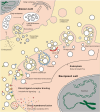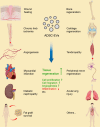Recent advances in the use of extracellular vesicles from adipose-derived stem cells for regenerative medical therapeutics
- PMID: 38844939
- PMCID: PMC11157933
- DOI: 10.1186/s12951-024-02603-4
Recent advances in the use of extracellular vesicles from adipose-derived stem cells for regenerative medical therapeutics
Abstract
Adipose-derived stem cells (ADSCs) are a subset of mesenchymal stem cells (MSCs) isolated from adipose tissue. They possess remarkable properties, including multipotency, self-renewal, and easy clinical availability. ADSCs are also capable of promoting tissue regeneration through the secretion of various cytokines, factors, and extracellular vesicles (EVs). ADSC-derived EVs (ADSC-EVs) act as intercellular signaling mediators that encapsulate a range of biomolecules. These EVs have been found to mediate the therapeutic activities of donor cells by promoting the proliferation and migration of effector cells, facilitating angiogenesis, modulating immunity, and performing other specific functions in different tissues. Compared to the donor cells themselves, ADSC-EVs offer advantages such as fewer safety concerns and more convenient transportation and storage for clinical application. As a result, these EVs have received significant attention as cell-free therapeutic agents with potential future application in regenerative medicine. In this review, we focus on recent research progress regarding regenerative medical use of ADSC-EVs across various medical conditions, including wound healing, chronic limb ischemia, angiogenesis, myocardial infarction, diabetic nephropathy, fat graft survival, bone regeneration, cartilage regeneration, tendinopathy and tendon healing, peripheral nerve regeneration, and acute lung injury, among others. We also discuss the underlying mechanisms responsible for inducing these therapeutic effects. We believe that deciphering the biological properties, therapeutic effects, and underlying mechanisms associated with ADSC-EVs will provide a foundation for developing a novel therapeutic approach in regenerative medicine.
Keywords: Adipose-derived stem cell; Extracellular vesicle; Regenerative medicine; Therapeutic effect; Tissue regeneration; Underlying mechanism.
© 2024. The Author(s).
Conflict of interest statement
The authors declare no competing interests.
Figures



Similar articles
-
Differential Therapeutic Effect of Extracellular Vesicles Derived by Bone Marrow and Adipose Mesenchymal Stem Cells on Wound Healing of Diabetic Ulcers and Correlation to Their Cargoes.Int J Mol Sci. 2021 Apr 8;22(8):3851. doi: 10.3390/ijms22083851. Int J Mol Sci. 2021. PMID: 33917759 Free PMC article.
-
Roles of extracellular vesicles from mesenchymal stem cells in regeneration.Mol Cells. 2024 Dec;47(12):100151. doi: 10.1016/j.mocell.2024.100151. Epub 2024 Nov 13. Mol Cells. 2024. PMID: 39547584 Free PMC article. Review.
-
Perspectives for Future Use of Extracellular Vesicles from Umbilical Cord- and Adipose Tissue-Derived Mesenchymal Stem/Stromal Cells in Regenerative Therapies-Synthetic Review.Int J Mol Sci. 2020 Jan 25;21(3):799. doi: 10.3390/ijms21030799. Int J Mol Sci. 2020. PMID: 31991836 Free PMC article. Review.
-
Extracellular Vesicles of Adipose-Derived Stem Cells Promote the Healing of Traumatized Achilles Tendons.Int J Mol Sci. 2021 Nov 16;22(22):12373. doi: 10.3390/ijms222212373. Int J Mol Sci. 2021. PMID: 34830254 Free PMC article.
-
Adipose-derived stem cell extracellular vesicles: A systematic review✰.J Plast Reconstr Aesthet Surg. 2019 Jul;72(7):1207-1218. doi: 10.1016/j.bjps.2019.03.008. Epub 2019 Mar 21. J Plast Reconstr Aesthet Surg. 2019. PMID: 30952587
Cited by
-
Microneedles in diabetic wound care: multifunctional solutions for enhanced healing.Burns Trauma. 2025 Feb 14;13:tkae076. doi: 10.1093/burnst/tkae076. eCollection 2025. Burns Trauma. 2025. PMID: 39958434 Free PMC article. Review.
-
Macrophage-driven exosomes regulate the progression of cardiovascular disease.Front Pharmacol. 2025 Apr 30;16:1563800. doi: 10.3389/fphar.2025.1563800. eCollection 2025. Front Pharmacol. 2025. PMID: 40371346 Free PMC article. Review.
-
Unraveling the Complex Cellular Repair Mechanisms Following Myocardial Infarction.Int J Mol Sci. 2025 Jun 23;26(13):6002. doi: 10.3390/ijms26136002. Int J Mol Sci. 2025. PMID: 40649781 Free PMC article. Review.
-
Research on the TSPAN6 regulating the secretion of ADSCs-Exos through syntenin-1 and promoting wound healing.Stem Cell Res Ther. 2024 Nov 15;15(1):430. doi: 10.1186/s13287-024-04004-8. Stem Cell Res Ther. 2024. PMID: 39548518 Free PMC article.
-
Dissolving microneedle patch loaded with adipokines-enriched adipose extract relieves atopic dermatitis in mouse via modulating immune disorders, microbiota imbalance, and skin barrier defects.J Tissue Eng. 2025 Feb 6;16:20417314241312511. doi: 10.1177/20417314241312511. eCollection 2025 Jan-Dec. J Tissue Eng. 2025. PMID: 39917589 Free PMC article.
References
Publication types
MeSH terms
Grants and funding
LinkOut - more resources
Full Text Sources
Research Materials

